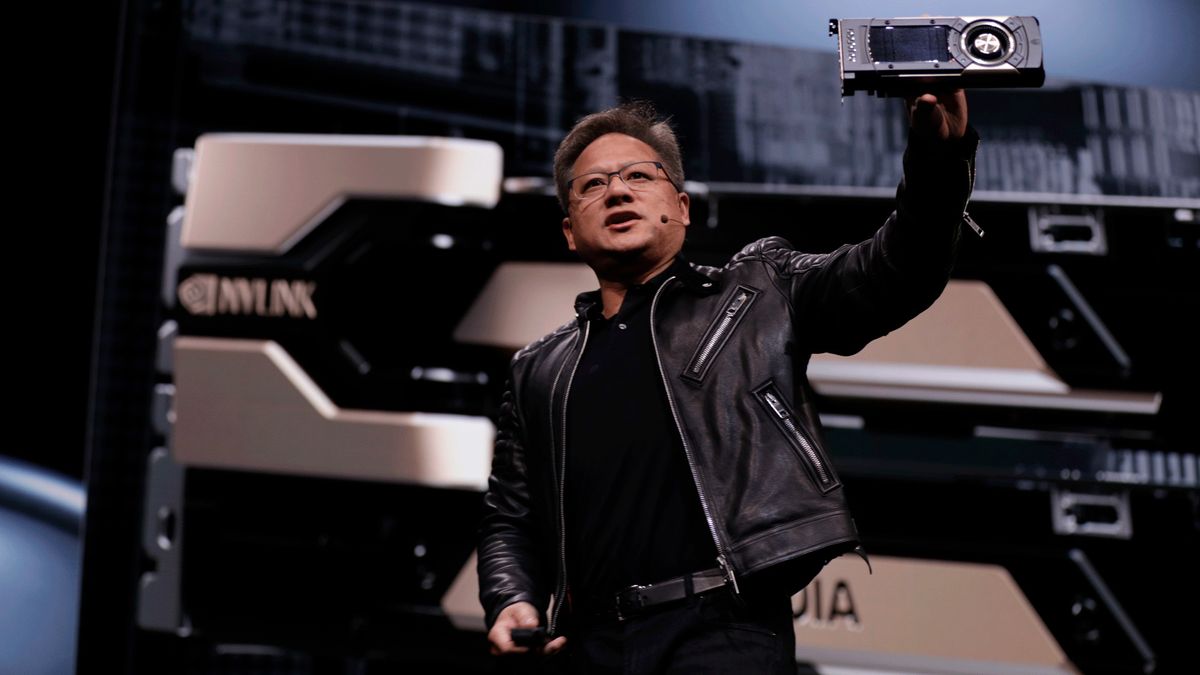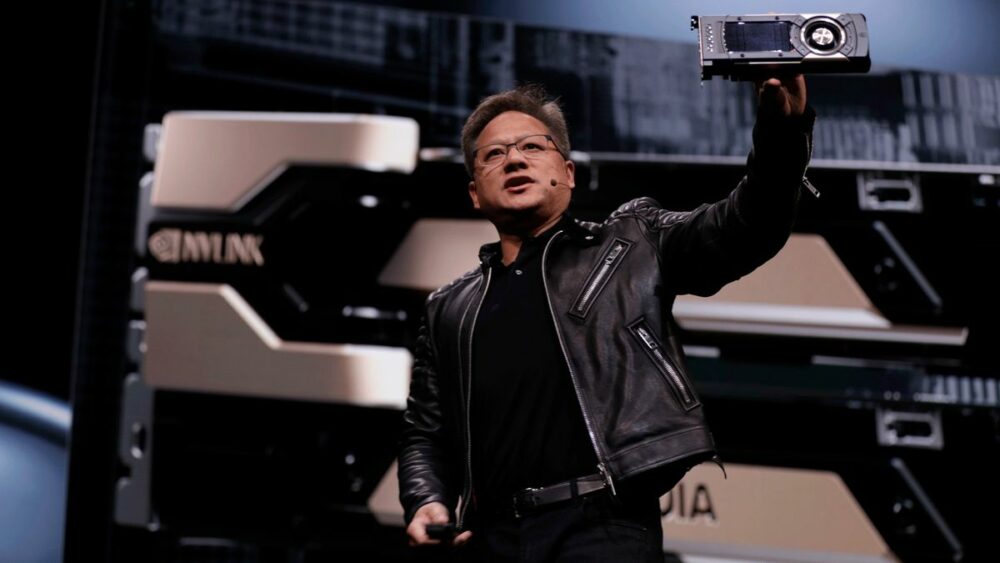
At this year’s New York Times Dealbook Summit, essentially a series of interviews with mega-wealthy CEOs, Jen-Hsun Huang of Nvidia was asked about why he constantly feels that his company may one day bite the dust. “I don’t think people are trying to put me out of business—I probably know they’re trying to,” he said. “I live in this condition where we’re partly desperate, partly aspirational.”
With a current market cap of $1.155 trillion, more than double what it was three years ago and the 6th largest in the world, Nvidia is exceedingly unlikely to ever actually go bust overnight. Huang co-founded the graphics giant in 1993, with Chris Malachowsky (currently Nvidia’s Senior VP of Engineering and Ops) and Curtis Priem (now retired), and has led the company since that time.
Things were pretty shaky in the early years but given that it now dominates the GPU and AI industries, you’d be forgiven for thinking that Jen-Hsun’s remarks are nothing more than a spot of marketing hyperbole.
“I like to live in that state where we’re about to perish, and so I enjoy that condition,” he explains, going on to say that he felt that he always does his best work in those circumstances.
Top-flight CEOs constantly battling with a fear of failure is common, so the polite laughs from the summit’s live audience weren’t from a sense of disbelief of Huang but rather a recognition that if you’re not wary and take your foot of the accelerator, then there will always be another competitor ready to jump in and take that top spot. Nvidia isn’t alone in the GPU/AI world: AMD and Intel are ever-present, of course, as are the rising number of chip firms in China.
In the same interview, Huang was asked for his thoughts on chip independence, i.e. having all of the major components required for a graphics card or AI accelerator being manufactured in the US. “Total supply chain independence is not a real practical thing for a decade or two,” he said, pointing out that some of Nvidia’s systems use as many as 32,000 parts.
If you take a standard Nvidia graphics card, the GeForce RTX 4060 for example, the main GPU is made by TSMC in Taiwan. The silicon chip is packaged by a different firm and then stored in distribution centers in Hong Kong. The manufacturing of the circuit board, memory chips, electronic components, heatsink, fans, and so on, are all done by dozens of companies, scattered around the world.
The most expensive and complex part is the GPU itself and at the moment, the most cost-effective way of making it is to use TSMC’s fabrication plants in Taiwan or Samsung’s facilities in South Korea. Having that all done exclusively in the US is the goal of chip independence but it’s a massive financial gamble, and possibly something that Jen-Hsun also frets about each morning.
Makes me rather glad that the only thing that stresses me out when I wake up is how cold the shower is going to be. Sure, mega-rich CEOs get to wipe their tears away with $10k bundles of notes but I’ll take the simple life every time.
- SEO Powered Content & PR Distribution. Get Amplified Today.
- PlatoData.Network Vertical Generative Ai. Empower Yourself. Access Here.
- PlatoAiStream. Web3 Intelligence. Knowledge Amplified. Access Here.
- PlatoESG. Carbon, CleanTech, Energy, Environment, Solar, Waste Management. Access Here.
- PlatoHealth. Biotech and Clinical Trials Intelligence. Access Here.
- Source: https://www.pcgamer.com/you-think-you-have-imposter-syndrome-nvidia-ceo-is-worried-his-trillion-dollar-company-might-go-bust-overnight
- 000
- 32
- a
- About
- accelerator
- actually
- ago
- AI
- All
- alone
- also
- always
- AMD
- and
- Another
- ARE
- around
- as
- At
- audience
- away
- battling
- BE
- being
- BEST
- board
- bundles
- bust
- but
- by
- Cap
- card
- ceo
- chain
- China
- chip
- Chips
- Chris
- Circuit
- circumstances
- cold
- Companies
- company
- Competitor
- complex
- components
- condition
- constantly
- cost-effective
- course
- Current
- currently
- day
- decade
- different
- distribution
- does
- Dollar
- don
- done
- double
- dozens
- e
- each
- Early
- electronic
- Engineering
- enjoy
- Essentially
- EVER
- Every
- Example
- exclusively
- expensive
- explains
- Facilities
- Failure
- fans
- Fear
- feels
- felt
- financial
- Firm
- firms
- For
- from
- gamble
- Gaming
- Get
- giant
- given
- go
- goal
- going
- GPU
- graphics
- has
- Have
- having
- he
- his
- HONG
- Hong Kong
- How
- HTML
- HTTPS
- huang
- i
- if
- in
- independence
- industries
- Intel
- Interview
- Interviews
- Is
- isn
- IT
- itself
- jpg
- jump
- know
- KONG
- korea
- largest
- Led
- Life
- like
- Live
- ll
- made
- main
- major
- Making
- Manufactured
- manufacturing
- many
- Marketing
- massive
- May
- me
- memory
- Memory chips
- might
- moment
- more
- morning
- most
- not
- notes
- nothing
- now
- number
- nvidia
- of
- on
- One
- only
- ops
- or
- out
- packaged
- part
- parts
- People
- plants
- plato
- plato data intelligence
- platodata
- platogaming
- possibly
- practical
- pretty
- probably
- put
- rather
- RE
- Ready
- Real
- recognition
- required
- rising
- s
- Said
- same
- Samsung
- say
- seasonal
- senior
- sense
- Series
- Silicon
- Simple
- since
- So
- some
- something
- South
- South Korea
- Spot
- standard
- State
- stored
- Summit
- supply
- supply chain
- sure
- Systems
- Taiwan
- Take
- than
- that
- The
- the world
- their
- then
- there
- they
- thing
- think
- Thinking
- this
- those
- three
- time
- times
- to
- top
- total
- trillion
- trying
- TSMC
- two
- unlikely
- up
- us
- use
- vp
- wake
- was
- way
- we
- were
- weren
- What
- when
- where
- why
- will
- wipe
- with
- Work
- world
- year
- years
- york
- you
- your
- youtube
- zephyrnet









